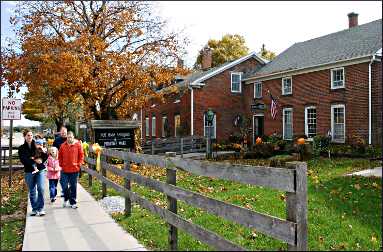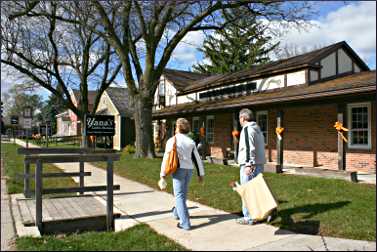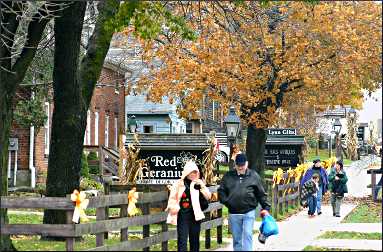Truly Amana
The busiest of Iowa's seven Amana Colonies is both a living historic monument and a shopping destination.

© Beth Gauper
It's obvious from one look at the shop-lined streets of Amana, the largest of the seven Amana Colonies, that modern commerce is in full flower there. Even so, the first question asked about the villages is: Are the Amana people Amish?
And no wonder — the people of the Amanas spoke German, lived simply and adhered faithfully to Scripture. Many still do. But no, they never were Amish.
The first people of the Amanas were German immigrants who came to Iowa in 1855.
They were devoutly religious, as were many of the time, but in addition they believed in Inspirationism — that God speaks to modern-day people through chosen Werkzeuge, the German word for tools, rather than ordained ministers.
The name they gave their Iowa settlement, Amana, comes from the Bible and means "remain true."
The Amish — and in fact, the largest community of Amish west of the Mississippi lives only 30 miles south of the Amanas, around Kalona — take their name from Jacob Ammann, a bishop born many years before the Community of True Inspiration was founded in 1714.
The Amish never were communal, but the people of the Amanas were.
That is, until 1932.
That was the year of the Great Change. A disastrous fire, an exodus of young people and the Depression's crippling effect on trade led the villages to drop the communal system to which they had held for nearly a century.
Today, capitalism flourishes, especially in the town of Amana, lined with quaint brick storefronts. And yet the church and German traditions remain, as do the trades in which the workers once pooled their skills.
This expertise — in weaving, woodcrafting, wine-making, basket-making, cooking — have made a lasting name for the colonies, especially among tourists.
Now, where kitchen bosses once directed meals made for 10 families, restaurants serve family-style, setting out heaping platters of smoked pork chops, roast beef and bowls of corn, mashed potatoes and sauerkraut.
I often visit Amana on the day after Thanksgiving, which, along with the day after Christmas, is one of the busiest of the year. There's much to see. At the Millstream Brewing Co., a brewer stood at the taps, putting curlicues of froth on small glass mugs of lager, Schild Brau Amber and wheat beer.

© Beth Gauper
"We follow the old German purity laws," he said. "Only four ingredients — hops, malt, yeast and water." Outside, bushy heads of hops poked through a weathered wood fence, where a beer garden is created for summer festivals.
Across the street at the Amana Woolen Mill, the arms and shuttles of a huge Swiss loom were rising and falling on skeins of black wool.
"They can make a blanket in three minutes," said a guide for the Amana Society, which owns the mill. "We used to make our own yarn, but now we buy it from all over."
Started in 1857, this is the last woolen mill still operating in Iowa. Only blankets — Scottish tartans, pastel baby comforters, cotton thermals — are made.
There are clothes for sale, but these, marked "Made for the Amana Woolen Mill," are made elsewhere.
At the Amana Furniture Shop, crowds of people were studying beautiful cherry armoires, walnut end tables, oak bed frames.
"Each craftsman works by himself on a project; it's not a production line," said Betty, who wore an Amana Society name tag. "And all our woods are solid; so many places take mixed woods and stain them to look solid."
The workshop is behind big gallery windows in the back, past the grandfather clocks in what once was the Amana Calico Works.
Amana also is the home of the Amana Heritage Museum, where a video explains that before the Great Change, everyone in the colonies — tinsmiths, cobblers, griddle-makers — received store credit in return for a full day's work and their presence in church.
According to the show, the switch to the profit-sharing Amana Society corporation, which still runs the mill, furniture shop, meat shop and many other enterprises, resulted in "a bruised idealism, an injured faith."
Many of the people who visit Amana are more interested in shopping than heritage, however.
Visitors stream in and out of the the Chocolate Haus, Amana Colonies Bakery & Cafe, the wineries and the Amana General Store, which once sold such staples as sugar and salt and now stocks upscale gifts.
Fine artists from Iowa and neighboring states have a showcase at Catiri's Art Oasis, filled with hand-blown glass, oil and pastel paintings, ceramic pots and jewelry.

© Beth Gauper
Tourists, who come by the busload, gravitate to the bakery, the chocolate store and the quilt shop.
But German traditions flourish. At the Amana Meat Shop, German-speaking octogenarian Carl Oehl sometimes holds court, handing out samples of Landjaeger, a dense German sausage, and joking with patrons. Shelves are filled with imported cookies, candies, honey and other German treats.
Amana restaurants serve sauerbraten, wiener schnitzel and spaetzle. During Oktoberfest, where Oehl has been the burgermeister, people test their speed at log-sawing and their strength in Maßkrugstemme (holding full mugs of beer).
At one of the B&Bs that have sprung up like the dandelions local wineries still use to make wine, I talked with a local bookkeeper, who had a distinct German accent. She was born and reared in High Amana, she said, as were her grown children, though they have only slight accents.
She smiled as she told me that, although some of the shop owners come from outside the Amana Colonies, most the employees are locals. The values and traditions of the old colonies, she said, have changed.
But she brightened when I asked about the craftsmanship for which the villages still are known.
"No, that stays," she said. "That hasn't changed. That can be handed down."
Trip Tips: Amana Colonies in Iowa
Getting there: It's half an hour west of Cedar Rapids and Iowa City, just north of Interstate 80.
Annual events: Late January, Winterfest. First weekend of May, Maifest. Mid-June, Wurst Festival. First weekend of October, Oktoberfest. First weekend of December, Prelude to Christmas.
Eating and shopping: For more, see Eating in Amana.
Accommodations: In Amana, the 65-room Hotel Millwright occupies part of the 160-year-old Amana Woolen Mill complex and includes a restaurant and bar.
The Guest House Motel in Amana has 38 rooms in two buildings, one modern and one an 1860 sandstone building once used as a communal kitchen.
There are also many small inns and B&Bs.
Nature trail: There are four segments of the Amana Society Nature Trail on a 135-acre wooded tract at the intersection of highways 6 and 151 near Homestead. The longest, 3.2 miles, leads to a bluff overlooking the Iowa River and a 250-year-old V-shaped Indian dam devised to catch fish.
Nightlife: The Iowa Theatre Artists Company offers theater and events.
Museum: The Amana Heritage Museum is open daily from April through October and Saturdays in March, November and December.
Information: Amana Colonies tourism, 319-622-7622.
Want to read about the Amish? There's a large community in southeast Minnesota, and several companies offer guided tours of Amish farms. See Amish country.